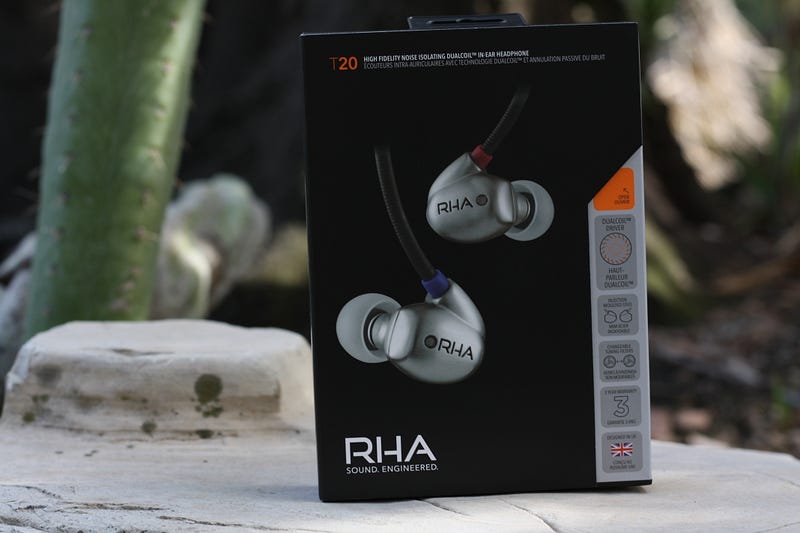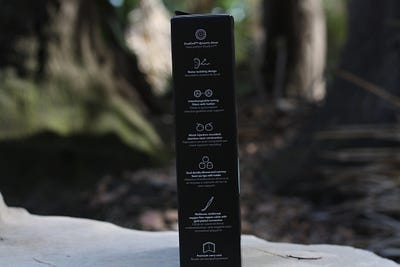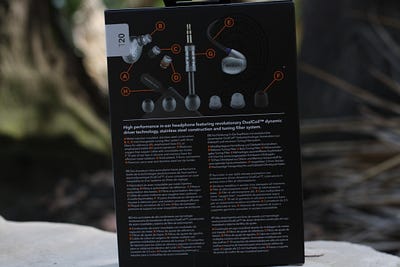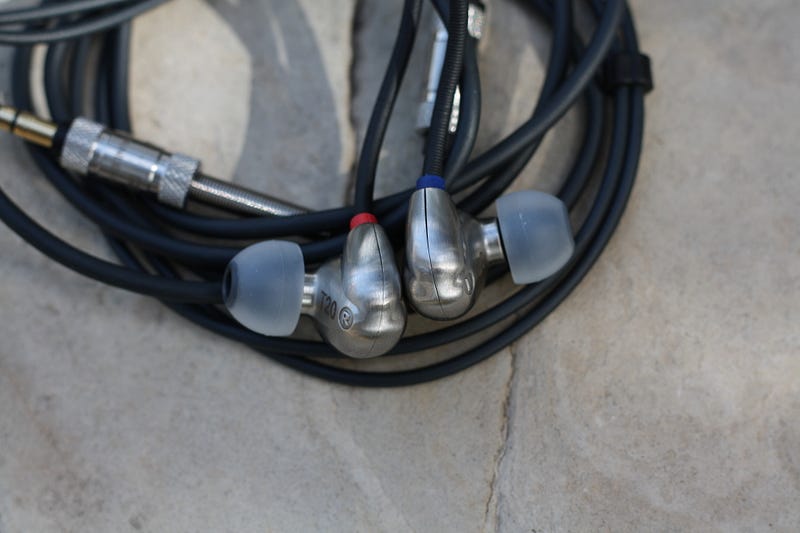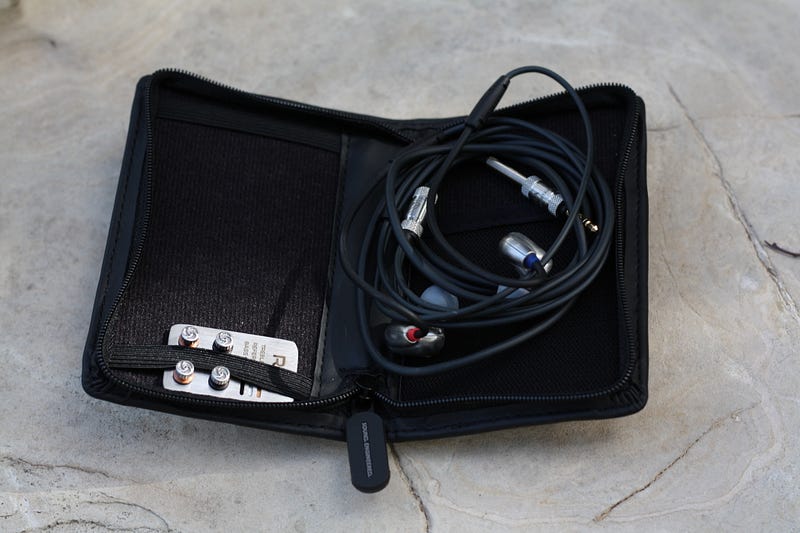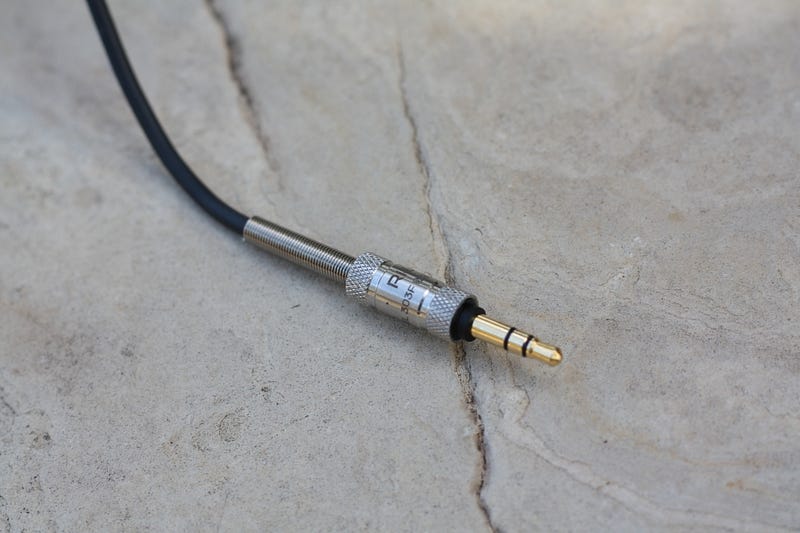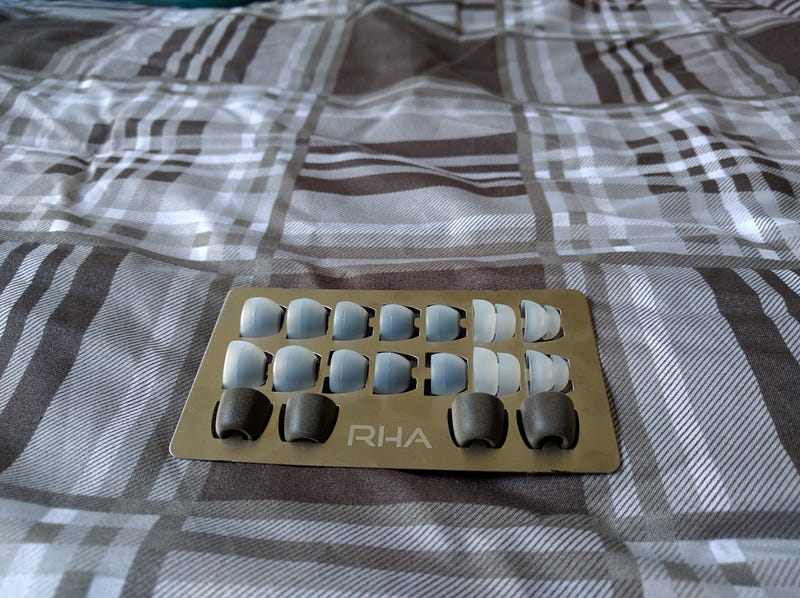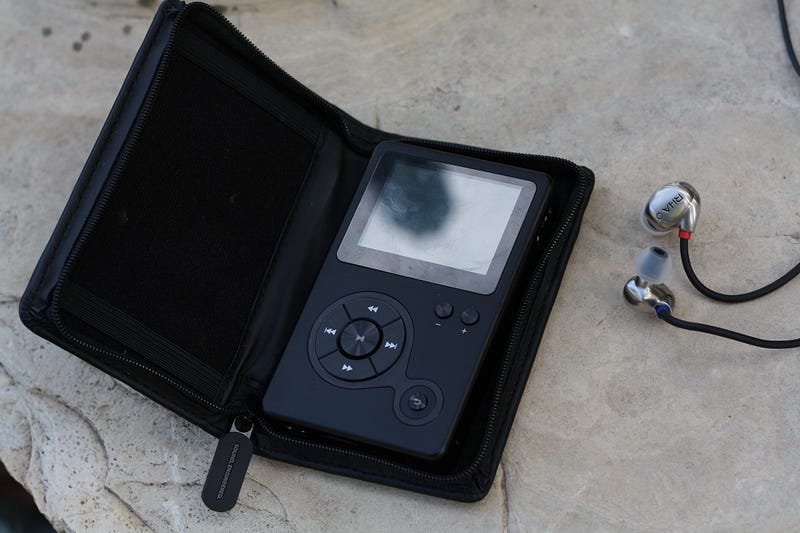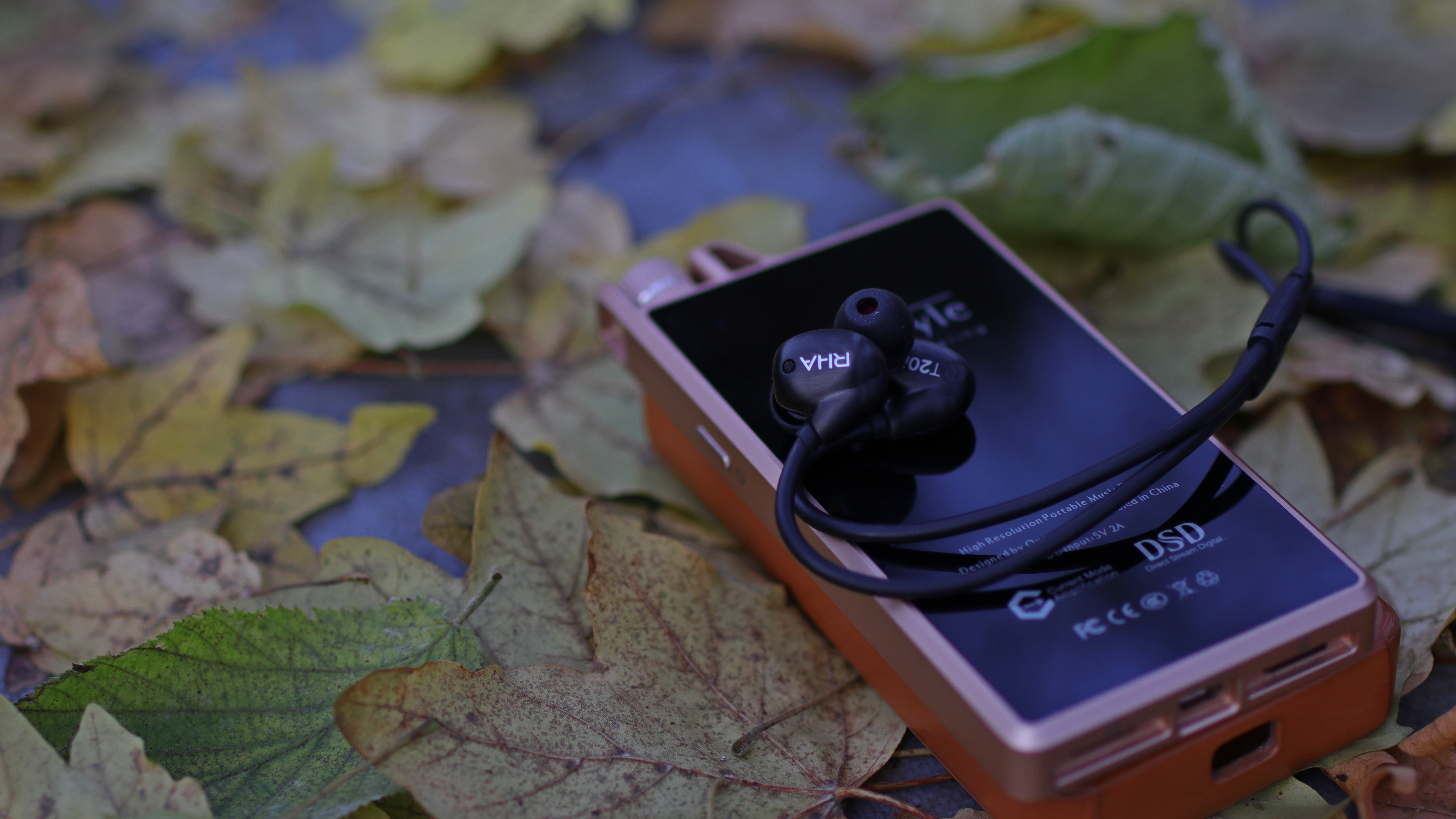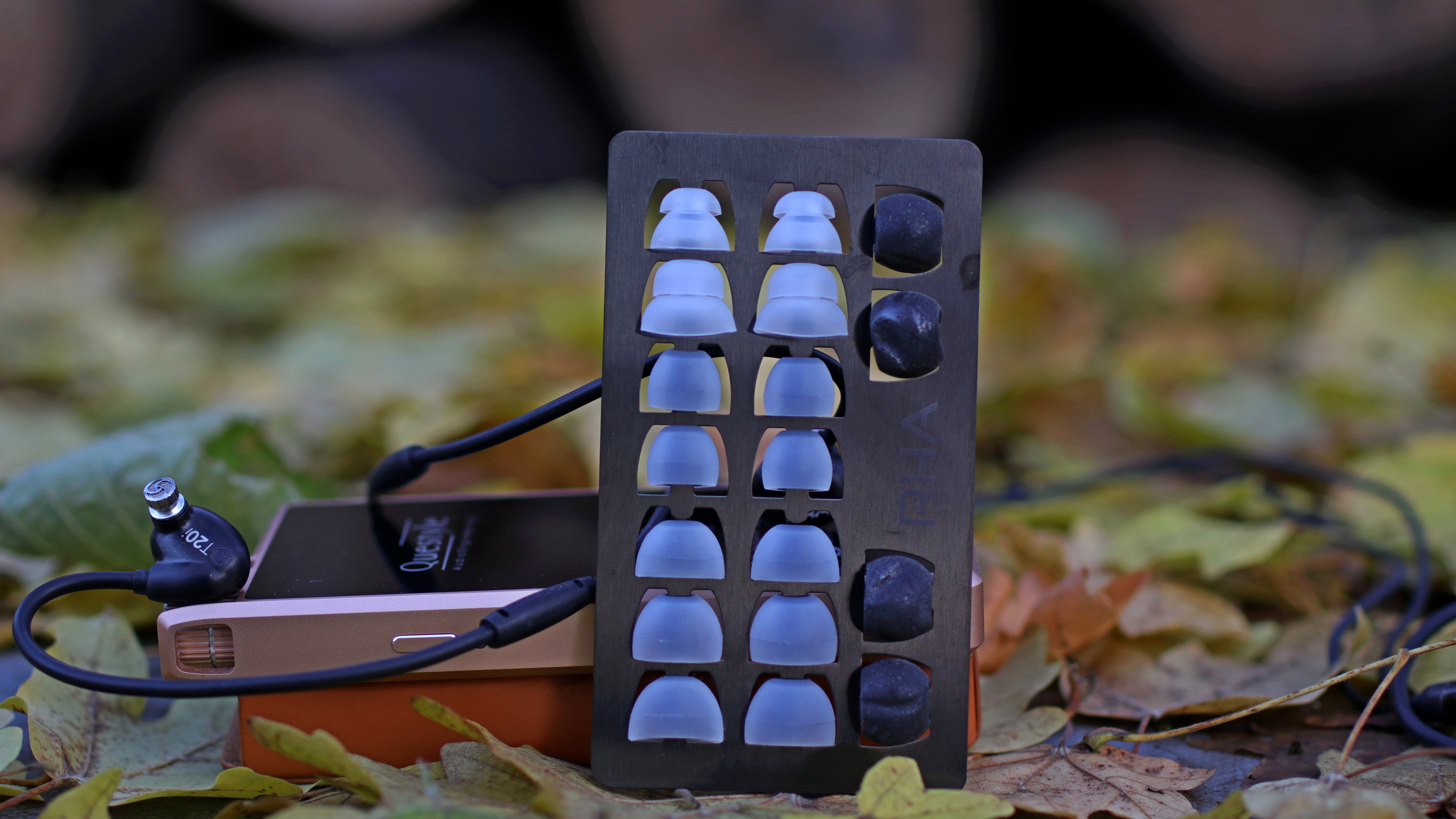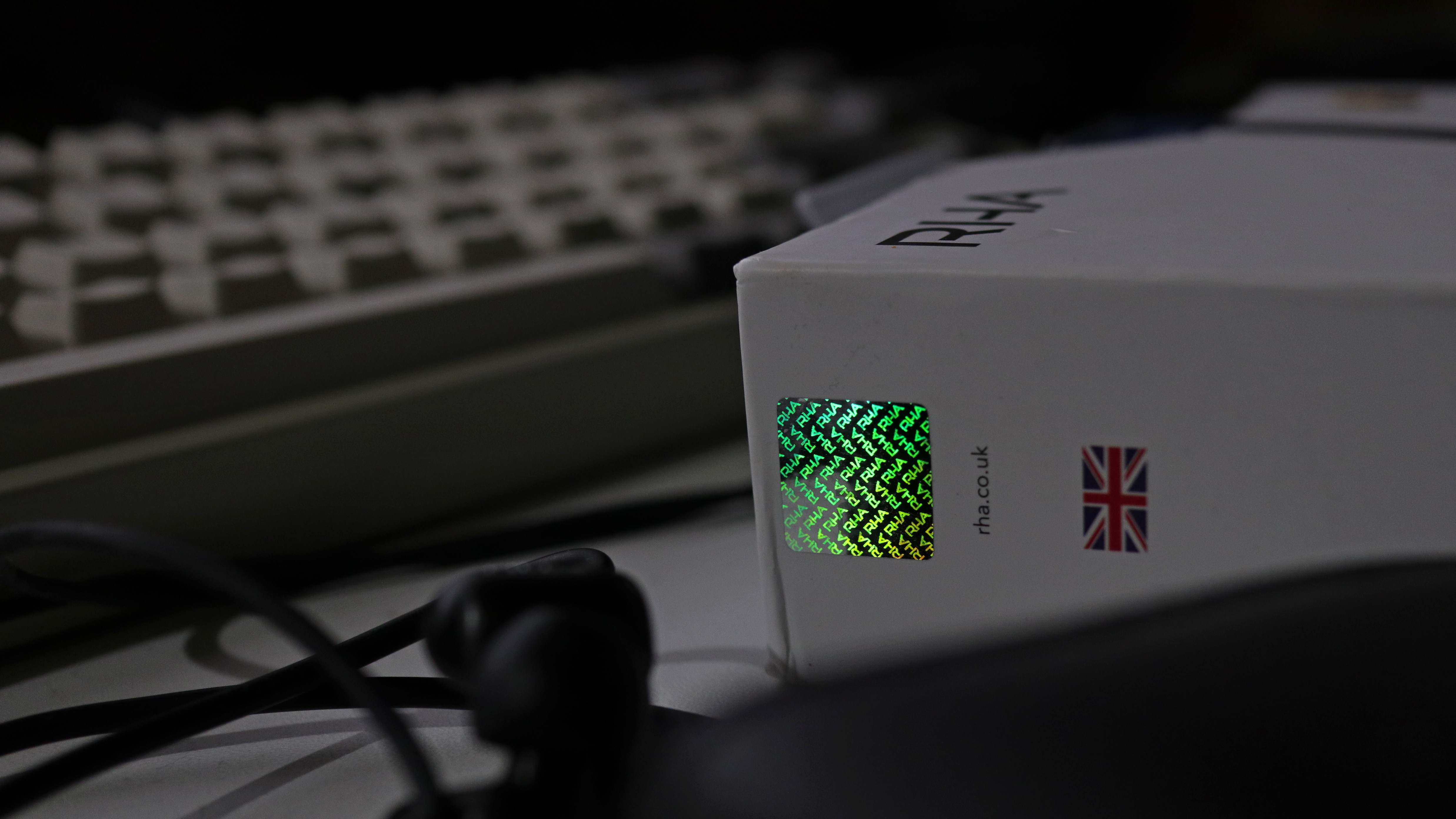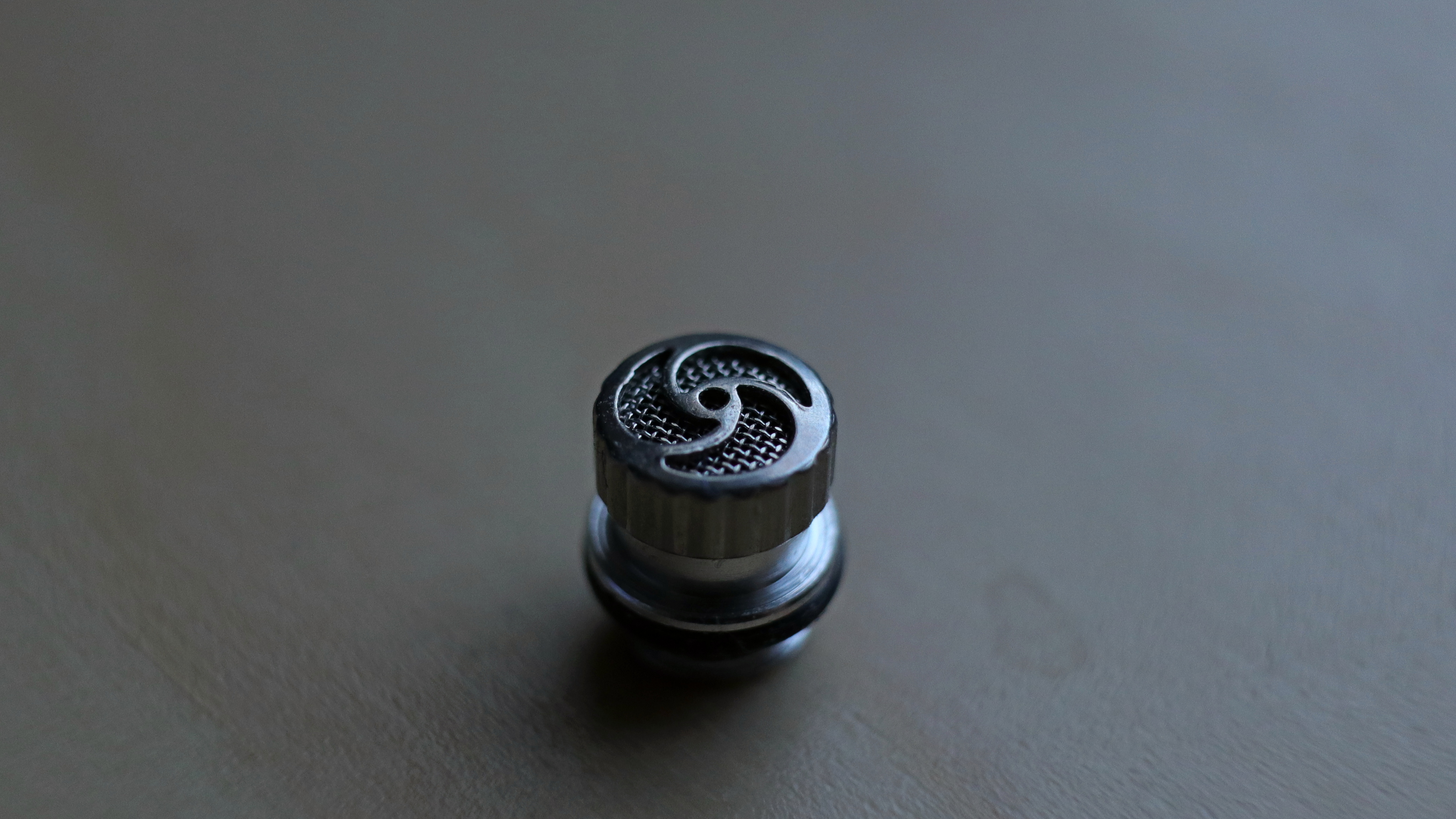RHA T20 Review
Introduction
RHA just launched the T20 in the UAE where I live. It was a great event in a brand new beautiful hotel, the TAJ Dubai, perfect choice, RHA
I was lucky enough to attend this event and got the chance to listen to the T20 and also listen to a review sample for the following days.
The way RHA is supporting the local distributor and the audiophile community is really exemplary and a shining example for other manufacturers in the region. Thanks as well to gadgitechme.com for their support. All pictures in this review can be viewed at full resolution. Just click on them.

one earpiece without tip of T20 in front, T10 in back
About RHA:
RHA is short for Reid Heath Audio - a Scottish headphone company that is still quite young but churning out better and better earphones with amazing quality and generous warranty.
From release to release RHA managed to up the quality and production value of their earphones. It seems that every detail they learned was implemented in the subsequent product - and they listen closely to what the community and customers have to say. A very interesting approach to start with the lower cost headphones and work your way up step by step. It's not the easiest way to establish a brand but I like it.
RHA produces their own drivers and uses metal housings for their headphones which makes them stand out from the competition.

T20 with another newby - Fiio X5ii
TL;DR
Does the T20 deliver: Yes. Clearly the new flagship in the RHA stable. Their best in-ear yet.
About myself:
As a benchmark: I am 42, my headphone inventory can be found in my profile. The test was conducted mostly with the Fiio X5ii, the CEntrance DACmini CX with 1 Ohm mod, the AK100, an iPhone 6 and lastly an iFi iDSD micro. I listen to an eclectic choice of music from industrial to classic, mostly FLAC and ALAC but also some MP3 320kbps and AAC 256 kbps thrown in.
I own the MA350, MA 750 and T10, none of the earphones I have from RHA have a microphone, the respective i-versions of these in-ears do have an iOS compatible remote and mic. The mic does work with most Android phones as well….



Manufacture’s Specifications
Design
The T20 is constructed with injection molded, stainless steel components. It has a thick and sturdy cable that is not replaceable. The design is identical to the T10 and T10i with the exception that the cable is now black instead of grey. Everything feels top quality and the 3 years warranty is certainly something you can believe in. The in-ear comes with replaceable metal tuning filters that alter the sound to a certain extend. RHA calls the driver technology “revolutionary” - well, we'll see about that later. Let me explain what is special on these drivers.

T10 and T20 next to each other. T20 has the black cable
Dual Coil Dynamic Driver:
This driver supposedly outperforms conventional drivers in resolution, clarity and detail with the use of two voice coils for one diaphragm. The way it works is that there is a voice coil on the outer edge of the diaphragm and one in the “normal” place in the middle of the diaphragm. The coils are operating independent from each other, the outer one (ring shaped) is responsible for the highs and the inner one for the lows. While we recently saw quite a few hybrid designs with in-ears using one or more balanced armature drivers and a dynamic driver, or dual drivers opposing or in line, etc, this is indeed a different approach.

Style
The metal body feels extremely well made and sturdy. Like the T10 before them, they are worn over the ear with a patent pending ear hook system. I don’t know what exactly is patent pending on it though, forgot to ask.

Build quality
Solid and reliable. Everything I mentioned in the review of the 750 is valid here too. They seem to be rock solid and should outlast man other headphones. And if not: they come with a 3 year warranty that should help with the peace of mind.
For a projected price slightly below $300 I would have loved to see a detachable cable.

Comfort
They slip into my ears like customs, I sound like a fanboy because if it comes to the fit with the T20 (or T10, MA750) I really am a fanboy. I have funny ear canals, right and left are different so finding something that is easy to insert and provides a great seal without filling around is really making me very happy. Others might not be as lucky but as the T10 these just fit perfect in my ears, comfortable for many hours, they “disappear” - they sit deep enough in your ears so you don’t feel their weight (39g).
Supplied accessories
Standard RHA fare. Nothing new from the MA750 or T10. A nice and soft carrying case (zip-up wallet style) made of soft touch plastic with compartments for all supplied accessories, including the metal tip holder. Great selection or ear tips: 6 pairs of silicone tips, two pairs of double flange tips and two pairs of memory foam tips (10 pairs in total). A clothing clip is also provided. Like the T10 the additional 2 pairs of tuning filters come screwed into a nice carrying plate made of brushed metal with a color coding on them to distinguish between the filters.

Carry case filled with accessories

Size comparison carry case

Supplied accessories

Sound tuning filters in their metal plate holder (screw in)
Sound
Ok, so the preliminary price of the T20 is $279 so around $80 more than the T10 and double the price of the MA750… So how does it stack up soundwise? I really liked the T10’s sound - however I found it a bit too thick on the bass, even though I consider myself a semi-basshead, but I like it well delivered and not bloated or overly emphasized. I am happy to say this has been fixed. The T20s indeed deliver everything the T10 did well and fixed most of the shortcomings. It's probably the most neutral in-ear from RHA so far.

Frequency response curve - red-treble filter, black bass filter, grey reference...
IMPORTANT NOTICE:
I have done the whole review with the reference filters. I will update this review when I have spend more time listening to the Treble and Bass filters.
REFERENCE FILTER IMPRESSIONS:
Bass
Punchy, fast and dry - lovely. This is the bass you want, not too overpowering like the T10 but so THERE if you need it. Hard to describe but the bass is extremely impactful when needed but has a bit of distance in it, so it hits you in front of your head - like with speakers or at a concert. In short - the bass is amazing and it hits hard when it needs to and is absent when it’s absent in the music. Not an easy feat. Way enhanced towards the T10 - Exactly the way I like it. The only criticism I might have is that really low sub bass quality could be a tad better. But then, this is complaining on a very high level.
Mid-range
More forward than the T10, giving this headphone a lovely fun signature. Female vocals sound great and full, male vocals are clean and engaging.
Treble
Haahhh, so much detail. While it’s not a multi balanced armature in-ear it does deliver a lot of detail and clarity indeed. Definitively increased from the T10, they do sound like BA drivers. Not sure how (well probably the dual coil) they did this but the range and detail of available on tap is amazing. With the reference filter the experience is amazing - such an extension from the T10. No wonder these in ears got the HiRes certification from the Japan Audio Society.

Since people asked: left T10 filters with screw up, right T20 filters. They are identical.

Filter sets are identical between the T10 and T20.
TREBLE FILTER IMPRESSIONS:
coming soon
BASS FILTER IMPRESSIONS:
vs. T10 with Reference Filter: Putting the bass filters on the T20 is elevating the bass back into basshead levels. Still articulate but it's a LOT of bass. I swapped back and forth with the T10 with Reference filter and must say, the bass is now on T10 level. However you still hear the slightly recessed mids from the T10 that come apparent in that A/B test. Testing the different filters shows, that the T10 is not a bad in ear at all.
vs. T10 with Bass Filter: Geeez, T10 whips the ass of the T20 in bass quantity - that's basshead calibre. The T10 is getting into bloated territory with the bass filters. It can be fun for some songs, but it's too much for me. But I can see the appeal for bass lovers with this filter.
Vs. T10 with treble filter: Still lots of bass on the T10 - however the treble can flow freely into your ears, makes the T10 more V-shaped and enjoyable for me. It's the same amount of bass as with the Reference filter but thanks to the less rolled off highs, you can listen to lower volume and here have a more balanced sound. For the T10 - these are my favorite filters.
Summary: The T20 with bass filter are close to the T10 with treble and reference filter in bass quantity. Quality remains better with the T20 though. They should please bass lovers with this filter... The bass is lovely elevated and still has lots of texture. Not my favorite filter for the T20 but clearly a fun thing to use with certain genres.

Sound Stage and instruments separations
The way you want it. Expansive but not overly expansive (or artificially large) but enough and I find it deeper than what you usually get in this price range. Pretty exciting balance. It reminds me of my Hifiman HE-560 which envelopes you in the music. The T20 can do that too. Precise and defined placement of instruments. Perfect. I thought long and hard what could be better, and I am not sure I could find something I was missing.

Plug of the T20 (left) and T10 (right) - reads: 303F - 522 for T20 and 303F - 448 for T10
Comparisons:
vs. T10:
- less bass bloat - bass still there and slightly boosted but never bloated or overbearing, impactful and dry
- midrange not as recessed, more forward, overall more pleasant
- a lot more treble extension, lots of details in the treble you might not find in the T10
EDIT: will add other comparisons later once I have made some head2head comparisons...
Pros & Cons
Pros:
Rating
Based on a price of $279 retail.
Conclusion
Quick recap of the 750 and T10: great build quality, 3 years warranty, great sounding, comfortable, great accessories from a great company.
The new flagship of the RHA line up delivers in spades. What I wrote in the 750 review still holds true, constant improvement and evolution is the name of the game. RHA took the best of the 750 and T10 and combined it with the T20. There is indeed more clarity and detail and the slightly flawed bass heavy T10 was tamed. Though a bit more sub bass (quality not quantity) would have been nice. The detail and clarity of this headphone is really astonishing. The treble is extended compared to the T10. Without being harsh, these are indeed better.
In a direct shoot out between the T10 and the T20 I found the T20 to be more involving, more enveloping, with a lot more detail and clarity in the treble. They are also louder and easier to drive than the T10 however the better the amp, the nicer they sound (not referring to power). This is still not a neutral earphone but way more neutral than the T10. As Warrenpchi put it: "the most balanced RHA unit I've heard this far, by a wide margin." That's exactly what I heard as well.

Used the T20 also for some X5 vs X5ii shoot out. T20 quickly became my favorite in-ear

Since some of you asked - sound level with T10 (volume matched via iPhone decibel meter app)

...and here the same volume with the T20, enlarge to see the small lines I added, yellow T20, red T10.
Why no i version?
That question was brought up a lot. RHA obviously thinks that people who buy a headphone like the T20 use it with a DAP and so don’t need a mic. I am not so sure. Personally I prefer not to have a microphone but I sure am in the minority. I guess an i version is in the works or at least seriously considered.
So…..: Yes, they are now my favorite in-ears under $300, maybe even above that price. As far as dynamic in-ears go, this could very well be the new benchmark. I used to use the 750 and T10 as well as the JVC HA-FX850, RE-400 and UE900s a lot before... but now… not so much. The T20, even after wearing off the new-toy-syndrome, is a hit. Properly driven this in-ears delivers. Well done, RHA, very well done.

T10 white/grey cable, T20 black cable
Update 21st June 2015:
Comparison to MA750:
In the right corner, the contender, with a fighting weight of 39g, the T20, in the left corner the reigning champion, with a fighting weight of 35g, the MaaaaaaaAAAAA SevenFiftyyyyyyyyyy.
The referee today is the Audioengine D3 24 bit DAC.
 MA750 vs T20 - FIGHT!
MA750 vs T20 - FIGHT!
Observations from this comparison:
Fundamentally the T20 with the reference filter share the same signature as the 750. They are clearly coming from the same producer, they share the "house sound" of RHA you could say.
But to throw in a Spinal Tap reference: The T20 go to 11.
This is what the T20 delivers above the 750:
- more immediate sound with a wider soundstage ( bit of an oxymoron here, the sound is closer to you but the soundstage is wider, if that makes any sense)
- more treble detail without being harsh
- hits harder and goes deeper in the bass and sub bass
A fuller, warmer sound with the T20s without loosing treble detail. The T20 with reference filter is an upgrade for any 750 owner. I can hands down recommend this, if it's in your budget. It's not 2 times better than the MA750 but you will have improvements in every area...it's a clear upgrade path for owners of the 750.
Disclaimer: RHA provided a T20 for review following their launch event in Dubai. I own the MA350, 750 and T10.
Introduction
RHA just launched the T20 in the UAE where I live. It was a great event in a brand new beautiful hotel, the TAJ Dubai, perfect choice, RHA

I was lucky enough to attend this event and got the chance to listen to the T20 and also listen to a review sample for the following days.
The way RHA is supporting the local distributor and the audiophile community is really exemplary and a shining example for other manufacturers in the region. Thanks as well to gadgitechme.com for their support. All pictures in this review can be viewed at full resolution. Just click on them.

one earpiece without tip of T20 in front, T10 in back
About RHA:
RHA is short for Reid Heath Audio - a Scottish headphone company that is still quite young but churning out better and better earphones with amazing quality and generous warranty.
From release to release RHA managed to up the quality and production value of their earphones. It seems that every detail they learned was implemented in the subsequent product - and they listen closely to what the community and customers have to say. A very interesting approach to start with the lower cost headphones and work your way up step by step. It's not the easiest way to establish a brand but I like it.
RHA produces their own drivers and uses metal housings for their headphones which makes them stand out from the competition.

T20 with another newby - Fiio X5ii
TL;DR
Does the T20 deliver: Yes. Clearly the new flagship in the RHA stable. Their best in-ear yet.
About myself:
As a benchmark: I am 42, my headphone inventory can be found in my profile. The test was conducted mostly with the Fiio X5ii, the CEntrance DACmini CX with 1 Ohm mod, the AK100, an iPhone 6 and lastly an iFi iDSD micro. I listen to an eclectic choice of music from industrial to classic, mostly FLAC and ALAC but also some MP3 320kbps and AAC 256 kbps thrown in.
I own the MA350, MA 750 and T10, none of the earphones I have from RHA have a microphone, the respective i-versions of these in-ears do have an iOS compatible remote and mic. The mic does work with most Android phones as well….



Manufacture’s Specifications
- Type: in-ear
- Drivers Size: ??
- Drivers Type: Dynamic with Dual Coil(TM)
- Frequency Response: 16Hz to 40KHz
- Sensitivity: 90dB @1mW
- Impedance: 16 Ω
Microphone sensitivity:- Maximum Input: 2/5mW
- Cable: multicore OFC, 1.35mm thick
- Weight with cable: 39g
- Connector: 3.5mm single ended
- MSRP: $279
Design
The T20 is constructed with injection molded, stainless steel components. It has a thick and sturdy cable that is not replaceable. The design is identical to the T10 and T10i with the exception that the cable is now black instead of grey. Everything feels top quality and the 3 years warranty is certainly something you can believe in. The in-ear comes with replaceable metal tuning filters that alter the sound to a certain extend. RHA calls the driver technology “revolutionary” - well, we'll see about that later. Let me explain what is special on these drivers.

T10 and T20 next to each other. T20 has the black cable
Dual Coil Dynamic Driver:
This driver supposedly outperforms conventional drivers in resolution, clarity and detail with the use of two voice coils for one diaphragm. The way it works is that there is a voice coil on the outer edge of the diaphragm and one in the “normal” place in the middle of the diaphragm. The coils are operating independent from each other, the outer one (ring shaped) is responsible for the highs and the inner one for the lows. While we recently saw quite a few hybrid designs with in-ears using one or more balanced armature drivers and a dynamic driver, or dual drivers opposing or in line, etc, this is indeed a different approach.

Style
The metal body feels extremely well made and sturdy. Like the T10 before them, they are worn over the ear with a patent pending ear hook system. I don’t know what exactly is patent pending on it though, forgot to ask.

Build quality
Solid and reliable. Everything I mentioned in the review of the 750 is valid here too. They seem to be rock solid and should outlast man other headphones. And if not: they come with a 3 year warranty that should help with the peace of mind.
For a projected price slightly below $300 I would have loved to see a detachable cable.

Comfort
They slip into my ears like customs, I sound like a fanboy because if it comes to the fit with the T20 (or T10, MA750) I really am a fanboy. I have funny ear canals, right and left are different so finding something that is easy to insert and provides a great seal without filling around is really making me very happy. Others might not be as lucky but as the T10 these just fit perfect in my ears, comfortable for many hours, they “disappear” - they sit deep enough in your ears so you don’t feel their weight (39g).
Supplied accessories
Standard RHA fare. Nothing new from the MA750 or T10. A nice and soft carrying case (zip-up wallet style) made of soft touch plastic with compartments for all supplied accessories, including the metal tip holder. Great selection or ear tips: 6 pairs of silicone tips, two pairs of double flange tips and two pairs of memory foam tips (10 pairs in total). A clothing clip is also provided. Like the T10 the additional 2 pairs of tuning filters come screwed into a nice carrying plate made of brushed metal with a color coding on them to distinguish between the filters.

Carry case filled with accessories

Size comparison carry case

Supplied accessories

Sound tuning filters in their metal plate holder (screw in)
Sound
Ok, so the preliminary price of the T20 is $279 so around $80 more than the T10 and double the price of the MA750… So how does it stack up soundwise? I really liked the T10’s sound - however I found it a bit too thick on the bass, even though I consider myself a semi-basshead, but I like it well delivered and not bloated or overly emphasized. I am happy to say this has been fixed. The T20s indeed deliver everything the T10 did well and fixed most of the shortcomings. It's probably the most neutral in-ear from RHA so far.

Frequency response curve - red-treble filter, black bass filter, grey reference...
IMPORTANT NOTICE:
I have done the whole review with the reference filters. I will update this review when I have spend more time listening to the Treble and Bass filters.
REFERENCE FILTER IMPRESSIONS:
Bass
Punchy, fast and dry - lovely. This is the bass you want, not too overpowering like the T10 but so THERE if you need it. Hard to describe but the bass is extremely impactful when needed but has a bit of distance in it, so it hits you in front of your head - like with speakers or at a concert. In short - the bass is amazing and it hits hard when it needs to and is absent when it’s absent in the music. Not an easy feat. Way enhanced towards the T10 - Exactly the way I like it. The only criticism I might have is that really low sub bass quality could be a tad better. But then, this is complaining on a very high level.
Mid-range
More forward than the T10, giving this headphone a lovely fun signature. Female vocals sound great and full, male vocals are clean and engaging.
Treble
Haahhh, so much detail. While it’s not a multi balanced armature in-ear it does deliver a lot of detail and clarity indeed. Definitively increased from the T10, they do sound like BA drivers. Not sure how (well probably the dual coil) they did this but the range and detail of available on tap is amazing. With the reference filter the experience is amazing - such an extension from the T10. No wonder these in ears got the HiRes certification from the Japan Audio Society.

Since people asked: left T10 filters with screw up, right T20 filters. They are identical.

Filter sets are identical between the T10 and T20.
TREBLE FILTER IMPRESSIONS:
coming soon
BASS FILTER IMPRESSIONS:
vs. T10 with Reference Filter: Putting the bass filters on the T20 is elevating the bass back into basshead levels. Still articulate but it's a LOT of bass. I swapped back and forth with the T10 with Reference filter and must say, the bass is now on T10 level. However you still hear the slightly recessed mids from the T10 that come apparent in that A/B test. Testing the different filters shows, that the T10 is not a bad in ear at all.
vs. T10 with Bass Filter: Geeez, T10 whips the ass of the T20 in bass quantity - that's basshead calibre. The T10 is getting into bloated territory with the bass filters. It can be fun for some songs, but it's too much for me. But I can see the appeal for bass lovers with this filter.
Vs. T10 with treble filter: Still lots of bass on the T10 - however the treble can flow freely into your ears, makes the T10 more V-shaped and enjoyable for me. It's the same amount of bass as with the Reference filter but thanks to the less rolled off highs, you can listen to lower volume and here have a more balanced sound. For the T10 - these are my favorite filters.
Summary: The T20 with bass filter are close to the T10 with treble and reference filter in bass quantity. Quality remains better with the T20 though. They should please bass lovers with this filter... The bass is lovely elevated and still has lots of texture. Not my favorite filter for the T20 but clearly a fun thing to use with certain genres.

Sound Stage and instruments separations
The way you want it. Expansive but not overly expansive (or artificially large) but enough and I find it deeper than what you usually get in this price range. Pretty exciting balance. It reminds me of my Hifiman HE-560 which envelopes you in the music. The T20 can do that too. Precise and defined placement of instruments. Perfect. I thought long and hard what could be better, and I am not sure I could find something I was missing.

Plug of the T20 (left) and T10 (right) - reads: 303F - 522 for T20 and 303F - 448 for T10
Comparisons:
vs. T10:
- less bass bloat - bass still there and slightly boosted but never bloated or overbearing, impactful and dry
- midrange not as recessed, more forward, overall more pleasant
- a lot more treble extension, lots of details in the treble you might not find in the T10
EDIT: will add other comparisons later once I have made some head2head comparisons...
Pros & Cons
Pros:
- sound quality
- comfort
- soundstage
- crazy versatile bass (with no bloat)
- high build quality, feels like it can withstand lots of abuse
- 3 years warranty and great customer service
- evolutionary step up from the MA750 and T10
- a bit heavier due to metal build (didn’t bother me at all but just want to mention it)
- no microphone i-version available yet
- needs some burn-in time to sound best (or brain burn-in)
- requires a good seal
- no detachable cable
Rating
- Comfort 9/10
- Sound Quality 10/10
- Design 9/10
- Durability 9/10
- Value for Money 8/10
Based on a price of $279 retail.
Conclusion
Quick recap of the 750 and T10: great build quality, 3 years warranty, great sounding, comfortable, great accessories from a great company.
The new flagship of the RHA line up delivers in spades. What I wrote in the 750 review still holds true, constant improvement and evolution is the name of the game. RHA took the best of the 750 and T10 and combined it with the T20. There is indeed more clarity and detail and the slightly flawed bass heavy T10 was tamed. Though a bit more sub bass (quality not quantity) would have been nice. The detail and clarity of this headphone is really astonishing. The treble is extended compared to the T10. Without being harsh, these are indeed better.
In a direct shoot out between the T10 and the T20 I found the T20 to be more involving, more enveloping, with a lot more detail and clarity in the treble. They are also louder and easier to drive than the T10 however the better the amp, the nicer they sound (not referring to power). This is still not a neutral earphone but way more neutral than the T10. As Warrenpchi put it: "the most balanced RHA unit I've heard this far, by a wide margin." That's exactly what I heard as well.

Used the T20 also for some X5 vs X5ii shoot out. T20 quickly became my favorite in-ear

Since some of you asked - sound level with T10 (volume matched via iPhone decibel meter app)

...and here the same volume with the T20, enlarge to see the small lines I added, yellow T20, red T10.
Why no i version?
That question was brought up a lot. RHA obviously thinks that people who buy a headphone like the T20 use it with a DAP and so don’t need a mic. I am not so sure. Personally I prefer not to have a microphone but I sure am in the minority. I guess an i version is in the works or at least seriously considered.
So…..: Yes, they are now my favorite in-ears under $300, maybe even above that price. As far as dynamic in-ears go, this could very well be the new benchmark. I used to use the 750 and T10 as well as the JVC HA-FX850, RE-400 and UE900s a lot before... but now… not so much. The T20, even after wearing off the new-toy-syndrome, is a hit. Properly driven this in-ears delivers. Well done, RHA, very well done.

T10 white/grey cable, T20 black cable
Update 21st June 2015:
Comparison to MA750:
In the right corner, the contender, with a fighting weight of 39g, the T20, in the left corner the reigning champion, with a fighting weight of 35g, the MaaaaaaaAAAAA SevenFiftyyyyyyyyyy.
The referee today is the Audioengine D3 24 bit DAC.
 MA750 vs T20 - FIGHT!
MA750 vs T20 - FIGHT!Observations from this comparison:
Fundamentally the T20 with the reference filter share the same signature as the 750. They are clearly coming from the same producer, they share the "house sound" of RHA you could say.
But to throw in a Spinal Tap reference: The T20 go to 11.
This is what the T20 delivers above the 750:
- more immediate sound with a wider soundstage ( bit of an oxymoron here, the sound is closer to you but the soundstage is wider, if that makes any sense)
- more treble detail without being harsh
- hits harder and goes deeper in the bass and sub bass
A fuller, warmer sound with the T20s without loosing treble detail. The T20 with reference filter is an upgrade for any 750 owner. I can hands down recommend this, if it's in your budget. It's not 2 times better than the MA750 but you will have improvements in every area...it's a clear upgrade path for owners of the 750.
Disclaimer: RHA provided a T20 for review following their launch event in Dubai. I own the MA350, 750 and T10.








